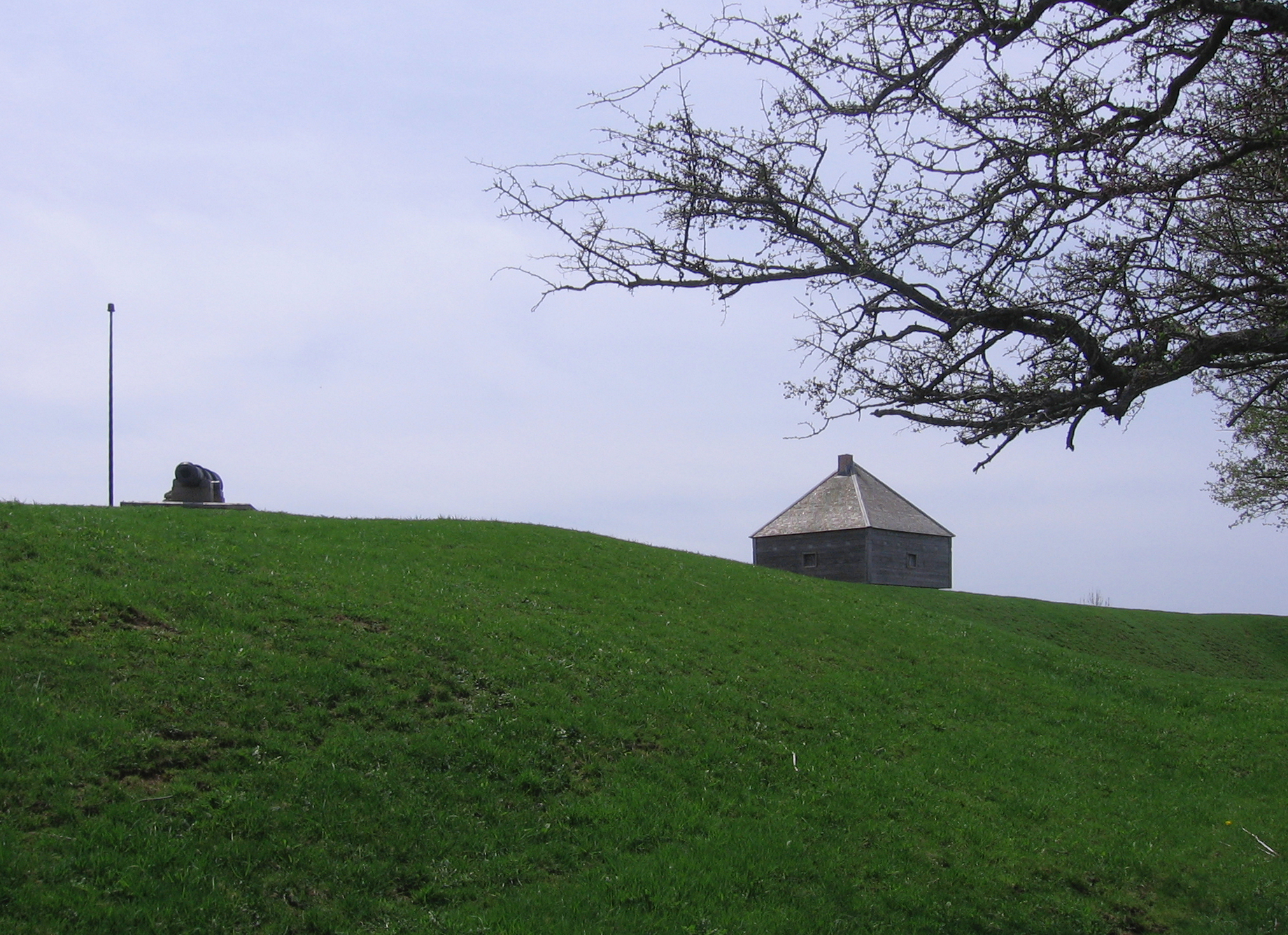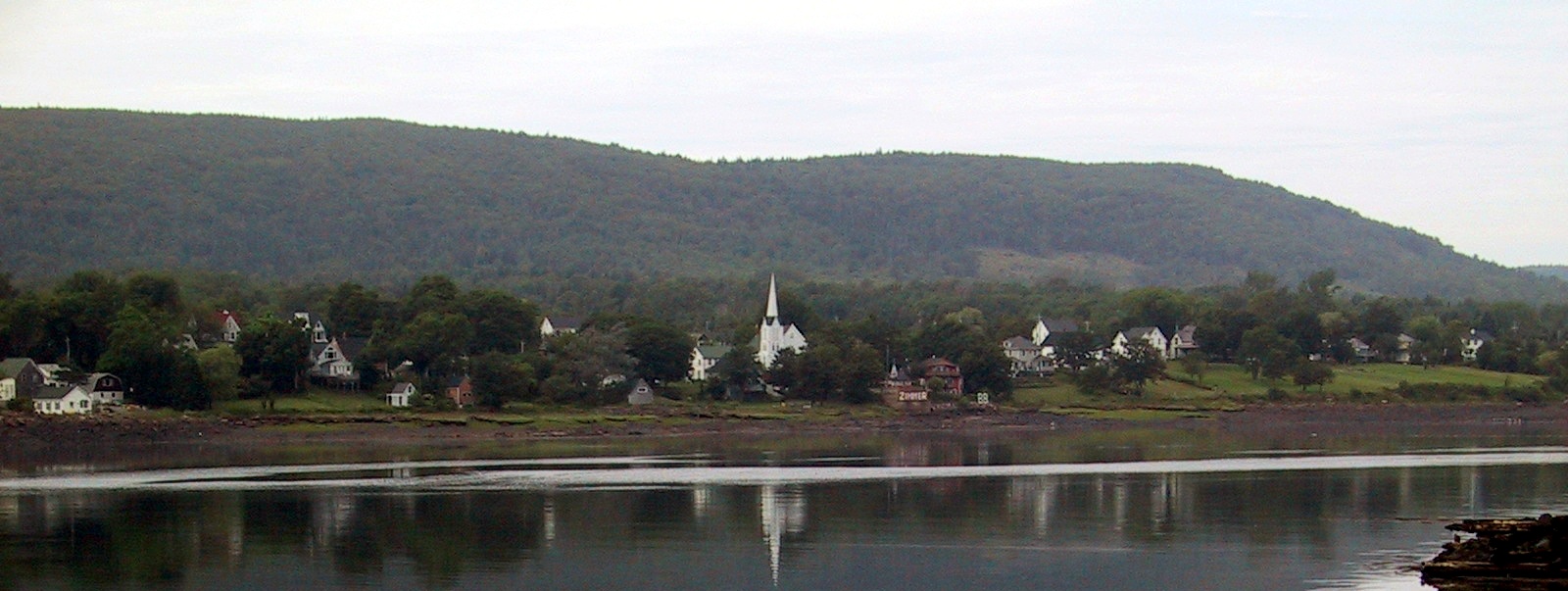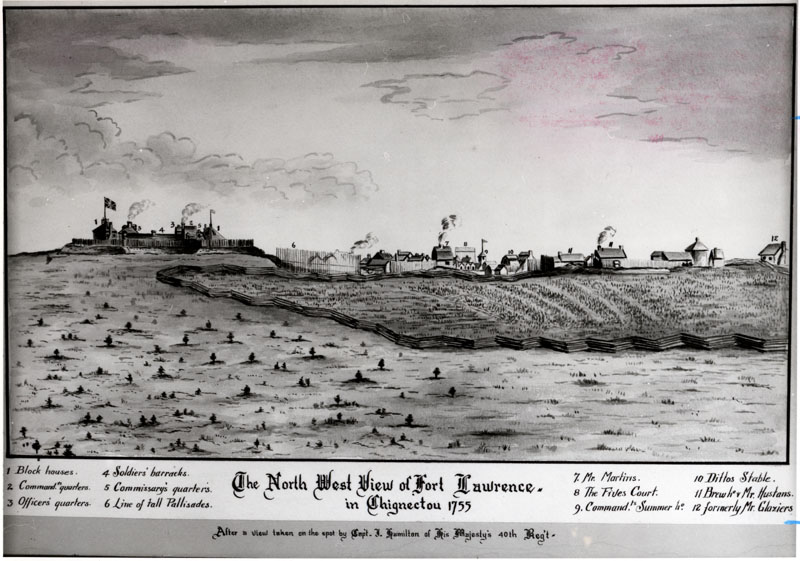|
Fort Edward (Nova Scotia)
Fort Edward is a National Historic Site of Canada in Windsor, Nova Scotia, (formerly known as Pisiguit) and was built during Father Le Loutre's War (1749-1755). The British built the fort to help prevent the Acadian Exodus from the region. The Fort is most famous for the role it played both in the Expulsion of the Acadians (1755) and in protecting Halifax, Nova Scotia from a land assault in the American Revolution. While much of Fort Edward has been destroyed, including the officers' quarters (which burned down in 1922) and barracks, the blockhouse that remains is the oldest extant in North America. A cairn was later added to the site. Father Le Loutre's War Despite the British Conquest of Acadia in 1710, Nova Scotia remained primarily occupied by ethnic French Catholic Acadians and Mi'kmaq. Father Le Loutre's War began when Edward Cornwallis arrived with 13 transports on 21 June 1749 to establish Halifax. To guard against Mi'kmaq, Acadian, and French attacks on the new B ... [...More Info...] [...Related Items...] OR: [Wikipedia] [Google] [Baidu] |
Windsor, Nova Scotia
Windsor is a community located in Hants County, Nova Scotia, Canada. It is a service centre for the western part of the county and is situated on Highway 101. The community has a history dating back to its use by the Mi'kmaq Nation for several millennia prior to European colonization. When the Acadians lived in the area, the town was raided by New England forces in 1704. The area was central to both Father Le Loutre's War and the Expulsion of the Acadians during the Bay of Fundy Campaign in 1755. The town promotes itself as the birthplace of ice hockey and was the home of Canada's first internationally best-selling author, Thomas Chandler Haliburton. On April 1, 2020, the Town of Windsor amalgamated with the District of West Hants to become the West Hants Regional Municipality. History Having migrated from Port Royal, Nova Scotia, the Acadians were the first to settle in Pisiguit by the early 1680s. French census records dated 1686 list well established farms utilizi ... [...More Info...] [...Related Items...] OR: [Wikipedia] [Google] [Baidu] |
Lunenburg, Nova Scotia
Lunenburg is a port town on the South Shore of Nova Scotia, Canada. Founded in 1753, the town was one of the first British attempts to settle Protestants in Nova Scotia. The economy was traditionally based on the offshore fishery and today Lunenburg is the site of Canada's largest secondary fish-processing plant. The town flourished in the late 1800s, and much of the historic architecture dates from that period. In 1995 UNESCO designated it a World Heritage Site. UNESCO considers the site the best example of planned British colonial settlement in North America, as it retains its original layout and appearance of the 1800s, including local wooden vernacular architecture. UNESCO considers the town in need of protection because the future of its traditional economic underpinnings, the Atlantic fishery, is now very uncertain. The historic core of the town is also a National Historic Site of Canada. Toponymy Lunenburg was named in 1753 after the Duke of Braunschweig-Lüneburg ... [...More Info...] [...Related Items...] OR: [Wikipedia] [Google] [Baidu] |
Nova Scotia Council
Formally known as "His Majesty's Council of Nova Scotia", the Nova Scotia Council (1720–1838) was the original British administrative, legislative and judicial body in Nova Scotia. The Nova Scotia Council was also known as the Annapolis Council (prior to 1749) and the Halifax Council (after 1749). After 1749, when the judicial courts were established, the Nova Scotia Council was limited to administrative and legislative powers. There was no legislative assembly in British-ruled Nova Scotia from the time of the conquest in 1710 until during the Seven Years' War in 1758. The Lords Commissioners for Trade and Plantations (or simply the Board of Trade) in London through much of the 1750s pressured the various governors in Nova Scotia to establish the General Assembly of Nova Scotia. The lack of civil government with an elected assembly was a drawback to attracting settlers from the older, established colonies of New England where the population was expanding and seeking new land ... [...More Info...] [...Related Items...] OR: [Wikipedia] [Google] [Baidu] |
Battle At St
A battle is an occurrence of combat in warfare between opposing military units of any number or size. A war usually consists of multiple battles. In general, a battle is a military engagement that is well defined in duration, area, and force commitment. An engagement with only limited commitment between the forces and without decisive results is sometimes called a skirmish. The word "battle" can also be used infrequently to refer to an entire operational campaign, although this usage greatly diverges from its conventional or customary meaning. Generally, the word "battle" is used for such campaigns if referring to a protracted combat encounter in which either one or both of the combatants had the same methods, resources, and strategic objectives throughout the encounter. Some prominent examples of this would be the Battle of the Atlantic, Battle of Britain, and Battle of Stalingrad, all in World War II. Wars and military campaigns are guided by military strategy, whereas bat ... [...More Info...] [...Related Items...] OR: [Wikipedia] [Google] [Baidu] |
Charles Lawrence (British Army Officer)
Brigadier-General Charles Lawrence (14 December 1709 – 19 October 1760) was a British military officer who, as lieutenant governor and subsequently governor of Nova Scotia, is perhaps best known for overseeing the Expulsion of the Acadians and settling the New England Planters in Nova Scotia. He was born in Plymouth, England, and died in Halifax, Nova Scotia. According to historian Elizabeth Griffiths, Lawrence was seen as a "competent", "efficient" officer with a "service record that had earned him fairly rapid promotion, a person of considerable administrative talent who was trusted by both Cornwallis and Hopson." He is buried in the crypt of St. Paul's Church (Halifax). Early career Lawrence was born in Plymouth (Devon) on 14 December 1709. He followed his father, General Charles John Lawrence, who is said to have served in Flanders under John Churchill, 1st Duke of Marlborough, into a military career. Charles Lawrence's earlier life is obscure. He was commissioned ... [...More Info...] [...Related Items...] OR: [Wikipedia] [Google] [Baidu] |
Isthmus Of Chignecto
The Isthmus of Chignecto is an isthmus bordering the Maritime provinces of New Brunswick and Nova Scotia that connects the Nova Scotia peninsula with North America. The isthmus separates the waters of Chignecto Bay, a sub-basin of the Bay of Fundy, from those of Baie Verte, a sub-basin of the Northumberland Strait that is an arm of the Gulf of St. Lawrence. The isthmus stretches from its northerly point at an area in the Petitcodiac River valley near the city of Dieppe, New Brunswick to its southerly point at an area near the town of Amherst, Nova Scotia. At its narrowest point between Amherst and Tidnish, the isthmus measures 24 kilometres wide. Because of its strategic position, it has been important to competing forces through much of its history of occupation. The name "Chignecto" derives from the Mi'kmaq name ''Siknikt'', meaning "drainage place"; the name of the Mi'kmaq District where the isthmus is located. Geography The majority of the lands comprising the isthmus ... [...More Info...] [...Related Items...] OR: [Wikipedia] [Google] [Baidu] |
Annapolis Royal, Nova Scotia
Annapolis Royal, formerly known as Port Royal, is a town located in the western part of Annapolis County, Nova Scotia, Canada. Today's Annapolis Royal is the second French settlement known by the same name and should not be confused with the nearby 1605 French settlement at the Port-Royal National Historic Site also known as the Habitation. In 1629 Scottish settlers established Charles Fort at a new location, but it was ceded to France in 1632 and became the second Port-Royal. This newer French settlement was renamed in honour of Queen Anne following the siege of Port Royal in 1710 by Britain. The town was the capital of Acadia and later Nova Scotia for almost 150 years, until the founding of Halifax in 1749. It was attacked by the British six times before permanently changing hands after the siege of Port Royal in 1710. Over the next fifty years, the French and their allies made six unsuccessful military attempts to regain the capital. Including a raid during the American R ... [...More Info...] [...Related Items...] OR: [Wikipedia] [Google] [Baidu] |
Fort Anne
Fort Anne (first established in 1629 as the Scottish Charles Fort) is a four-bastion fort built to protect the harbour of Annapolis Royal, Nova Scotia. The fort repelled all French attacks during the early stages of King George's War. Now designated a National Historic Site of Canada, it is managed by Parks Canada. Two buildings remain intact: * The 1708 stone powder magazine in Bourgogne Bastion * The 1797 Officer's Quarters was renovated in the 1930s and now house the museum with exhibits about the fort's history and historic artifacts from the area. It was former site of two separate structures: Governor's house and chapel. Other structures were replaced by later work by British: * Bake house in Dauphin Bastion later became underground magazine * Powder magazine in Berry Bastion now vacant Lieutenant Governor house and dry storage building in front of current officers quarters demolished. Currently vacant area. A trail runs along the fort's earthen walls, and provides a ... [...More Info...] [...Related Items...] OR: [Wikipedia] [Google] [Baidu] |
Fort Lawrence
Fort Lawrence was a British fort built during Father Le Loutre's War and located on the Isthmus of Chignecto (in the modern-day community of Fort Lawrence). Father Le Loutre's War Despite the British Conquest of Acadia in 1710, Nova Scotia remained primarily occupied by Catholic Acadians and Mi'kmaq. Father Le Loutre's War began after Edward Cornwallis arrived to establish Halifax with 13 transports on June 21, 1749. The British quickly began to build other settlements. To guard against Mi'kmaq, Acadian and French attacks on the new Protestant settlements, British fortifications were erected in Halifax (1749), Bedford (Fort Sackville) (1749), Dartmouth (1750), Lunenburg (1753), and Lawrencetown (1754). Within 18 months of establishing Halifax, the British also took firm control of peninsula Nova Scotia by building fortifications in all the major Acadian communities: present-day Windsor ( Fort Edward); Grand-Pré (Fort Vieux Logis) and Chignecto (Fort Lawrence). A British fort ... [...More Info...] [...Related Items...] OR: [Wikipedia] [Google] [Baidu] |



_by_Dominic_Serres%2C_c._1765.jpg)



